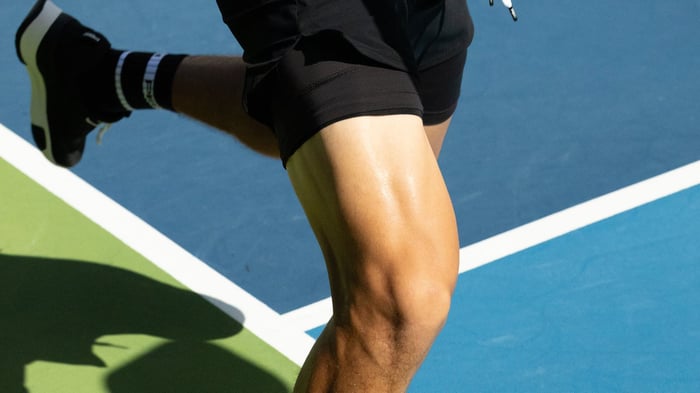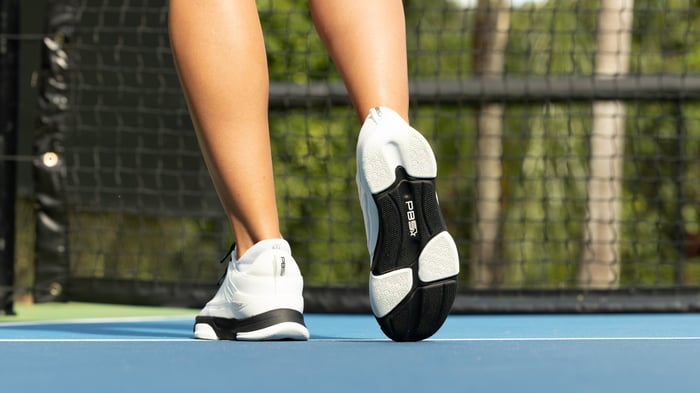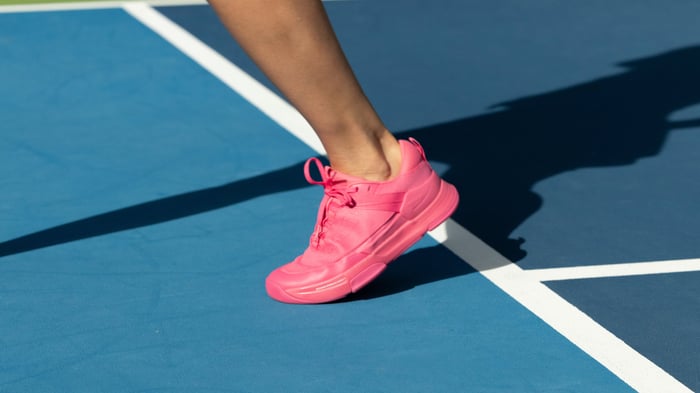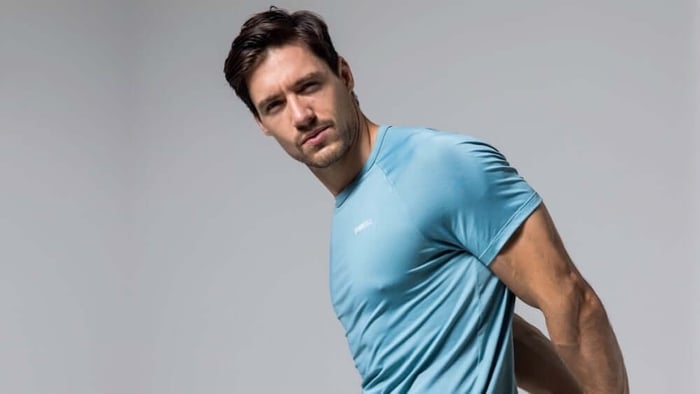Key takeaways:
Pickleball-related foot and ankle injuries have significantly increased, making it essential for players to understand and prevent common foot issues.
Proper footwear, such as the PB5 Court2 shoes with Dynamic Stability Assist™, is crucial for injury prevention and enhancing performance on the court.
Incorporating warm-ups, foot and ankle strengthening exercises, and paying attention to court surfaces are effective strategies to minimize the risk of foot injuries in pickleball.
Pickleball is booming. As a seasoned podiatrist, I’ve watched this fast-growing sport win over athletes of all ages—and I understand why. It’s social, energetic, and a great way to stay active. But with that surge in popularity, I’ve also seen a sharp uptick in foot and ankle injuries directly tied to the nature of pickleball’s movement.
This sport demands quick lateral shifts, sudden stops, and explosive starts. Those motions are incredibly fun, but they also put a lot of stress on the lower body, especially the feet. Here’s what I’ve observed in my practice and how you can stay healthy and injury-free while enjoying your time on the court.
The most common pickleball foot injuries
Pickleball’s fast pace and constant movement can take a real toll on your feet. From weekend warriors to seasoned players, foot and ankle injuries are becoming more common as the sport grows.
Here are the main injuries to look out for:
Ankle sprains. Quick lateral movements are part of what makes pickleball so fun, but they also put serious strain on the ankle. If your shoes don’t offer enough rear foot control or side-to-side stability, it’s easy for your ankle to roll during a fast lunge or pivot, leading to pain, swelling, and a potential time-out from the court.
Plantar fasciitis. This one’s a real heel — literally. Caused by inflammation of the thick band running along the bottom of your foot, plantar fasciitis shows up as sharp pain in the heel or arch, especially after rest. It often stems from shoes that lack proper shock absorption or arch support during those sudden starts and stops.
Achilles tendonitis. If the back of your heel starts feeling stiff or sore, your Achilles might be calling for attention. This tendon absorbs a lot of force in pickleball, especially during quick bursts of speed or when players don’t warm up properly. Without the right support, it’s easy for irritation to build up over time.
Stress fractures. Less common but still worth noting, stress fractures can result from repeated impact on hard surfaces. They typically start as a dull ache and progress into sharper, localized pain, often worsening the longer you play.
Staying aware of these injuries and knowing the signs can make a big difference in your long-term game. With the right prep, proper footwear, and a bit of injury prevention know-how, you’ll be able to keep moving, competing, and enjoying every rally.
How to prevent foot injuries in pickleball
If you want to keep playing your best and avoid sitting out with aches and pains, taking care of your feet is non-negotiable. The good news? A few smart habits can go a long way in preventing common foot and ankle injuries on the court. The following tips are what I tell my own patients, and they’re easy to work into your routine:
Warm up the right way. I can’t stress this enough. Your muscles and joints need time to prep for action. So, before you dive into a match, take a few minutes to get your body moving. Do some dynamic stretches like high knees, butt kicks, and leg swings to help wake up your muscles, boost circulation, and prep your lower body for the quick stops and starts of pickleball.
Strengthen the right muscles. If you’ve had ankle issues before, you need to be proactive. Simple exercises like ankle rotations, calf raises, or balance drills can boost your stability and help you stay grounded. If you’re prone to ankle sprains, strengthening the peroneal muscles and doing proprioceptive work (think single-leg balance exercises) can help you stay stable and react quickly on the court.
Choose the right shoes. This is where many players go wrong. Running shoes aren’t made for lateral motion. You need court-specific footwear with proper side-to-side stability, heel cushioning, and arch support. Instead, look for court-specific footwear that offers solid side-to-side stability, heel cushioning, and arch support like PB5 Court2 shoes that feature Dynamic Stability Assist™ to help absorb shock and keep your feet steady.
Listen to your body. Pain is your body’s warning signal. Don’t ignore it. If something feels off, taking a break can prevent a minor issue from turning into something that keeps you off the court for weeks.
The best shoes to prevent pickleball injuries
At my podiatry practice, I often remind patients that shoes aren’t just accessories—they’re equipment. And in a high-impact, quick-cut sport like pickleball, your footwear can either be your greatest asset or your weakest link.
The right pair of shoes supports the mechanics of your foot, cushions against repetitive stress, and keeps you stable during aggressive lateral movements. The wrong pair? It can lead to rolled ankles, chronic heel pain, and wear-and-tear injuries that keep you off the court for weeks.
So, what exactly should you look for in a pickleball shoe? Here’s a quick breakdown:
Lateral support to handle those rapid direction changes without rolling your ankle.
A stiff medial counter and rearfoot stability to keep your foot locked in during lunges and quick stops.
Deep heel cushioning to reduce strain on your Achilles and plantar fascia.
Strong arch support to maintain alignment and distribute weight evenly.
A wide toe box to prevent friction, blisters, and toe injuries.
The PB5 Court2 shoes hits all of those marks. It features a removable, supportive footbed with deep heel seating and targeted arch reinforcement. Plus, its multidirectional outsole grips the court without being overly sticky, which reduces injury risk from catching your foot mid-move. Learn more about PB5star footwear here.
Frequently asked questions about pickleball injuries
How long should I wait before returning to play after a foot or ankle injury?
As a general rule, I recommend waiting until you're completely pain-free and have regained full range of motion and strength before stepping back on the court. That often means at least 1–2 weeks for mild sprains, and potentially 4–6 weeks (or more) for more serious injuries like stress fractures or moderate tendonitis. It’s best to consult a podiatrist or physical therapist for a personalized recovery plan, as returning too soon can lead to reinjury or chronic issues.
Are custom orthotics necessary for pickleball players?
Not always—but in certain cases, yes. If you have flat feet, high arches, a history of plantar fasciitis, or recurrent ankle injuries, custom orthotics can provide targeted support and alignment that off-the-shelf shoes may not offer. I often recommend orthotics for players who experience recurring symptoms despite wearing proper court shoes. They can be a game-changer in distributing pressure and improving biomechanics.
What’s the difference between indoor and outdoor pickleball shoes, and does it matter?
Yes, it matters, especially for traction and durability. Indoor courts usually require shoes with softer, non-marking rubber outsoles designed for wood or gym surfaces. Outdoor courts (which are typically rougher, like asphalt or concrete) demand tougher soles with more grip and abrasion resistance. If you play on both surfaces, consider rotating between two pairs built specifically for each environment to preserve cushioning and performance.
Elevate your game with PB5star
If you love pickleball, you know how important it is to stay healthy and on your feet. Taking care of your foot health isn’t just about avoiding injuries—it’s about showing up strong, confident, and ready to play your best game. By understanding common foot issues and being proactive about prevention, we can all enjoy more time on the court doing what we love.
And if you’ve had recurring foot or ankle issues, or if you’re just getting into the sport and want to set yourself up for success, consider seeing a podiatrist. A quick consultation can help you understand your foot type, identify risk areas, and find the footwear and stretches that work best for your body.
At PB5star, we're here to support every step of your pickleball journey. Our PB5 Court2 shoes for men and women are designed with performance, protection, and comfort in mind, so you can move confidently, play harder, and stay on the court longer. Let’s keep our community strong, healthy, and always ready for the next rally.







